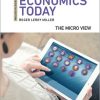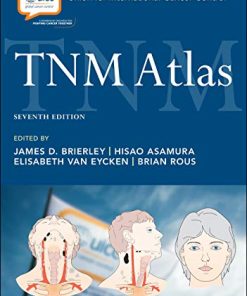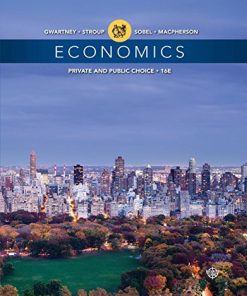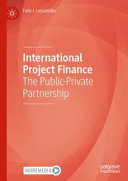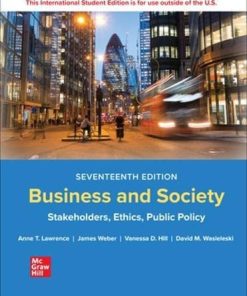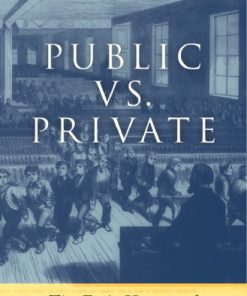Economics Private and Public Choice 17th Edition by James Gwartney 9798214349091
$50.00 Original price was: $50.00.$25.00Current price is: $25.00.
Economics: Private & Public Choice 17th Edition by James D. Gwartney – Ebook PDF Instant Download/DeliveryISBN: 9798214349091
Full download Economics: Private & Public Choice 17th Edition after payment.
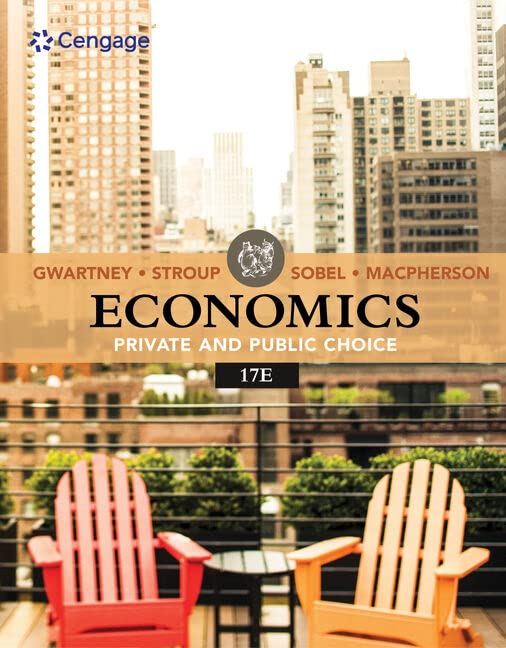
Product details:
ISBN-13 : 9798214349091
Author : James D. Gwartney
Teach students to apply microeconomics as Gwartney/Stroup/Sobel/Macpherson’s MICROECONOMICS: PRIVATE AND PUBLIC CHOICE, 17E places more emphasis than similar texts on the role of entrepreneurship in a market economy and the importance of public choice analysis in understanding the political process. New coverage presents entrepreneurship as key to grasping how the competitive market uses innovations to improve living standards. Students also see how public choice analysis clarifies incentives and impacts political outcomes — which, in turn, affect national income. Introductory chapters cover basic microeconomic thinking and use the “invisible hand” metaphor to show how wealth is created. The authors integrate entrepreneurship, the dynamic process of competition and importance of contestable markets into standard models of firm behavior in different markets. Special features highlight economics of health care, earning differences between genders and the Great Suppression of 2020 related to the COVID-19 pandemic.
Economics: Private & Public Choice 17th Table of contents:
Part 1. The Economic Way of Thinking
Chapter 1. The Economic Approach
1-1. What Is Economics About?
1-1a. Scarcity and Poverty Are Not the Same
1-1b. Scarcity Necessitates Rationing
1-1c. The Method of Rationing Influences the Nature of Competition
1-2. The Economic Way of Thinking
1-2a. Eight Guideposts to Economic Thinking
1-3. Positive and Normative Economics
1-4. Pitfalls to Avoid in Economic Thinking
1-4a. Violation of the Ceteris Paribus Condition Can Lead One to Draw the Wrong Conclusion
1-4b. Good Intentions Do Not Guarantee Desirable Outcomes
1-4c. Association Is Not Causation
1-4d. The Fallacy of Composition: What’s True for One Might Not Be True for All
Key Points
Critical Analysis Questions
Chapter 2. Some Tools of the Economist
2-1. What Shall We Give Up?
2-1a. Opportunity Cost
2-1b. Opportunity Cost and the Real World
2-2. Trade Creates Value
2-2a. Transaction Costs—A Barrier to Trade
2-2b. The Middleman as a Cost Reducer
2-3. The Importance of Property Rights
2-3a. Private Ownership and Markets
2-4. Production Possibilities Curve
2-4a. Shifting the Production Possibilities Curve Outward
2-4b. Production Possibilities and Economic Growth
2-5. Trade, Output, and Living Standards
2-5a. Gains from Specialization and Division of Labor
2-5b. Gains from Mass Production Methods
2-5c. Gains from Innovation
2-6. Human Ingenuity, Entrepreneurship, and the Creation of Wealth
2-7. Economic Organization
2-7a. Market Organization
2-7b. Political Organization
Key Points
Critical Analysis Questions
Addendum. Comparative Advantage, Specialization, and Gains from Trade
Part 2. Markets and Government
Chapter 3. Demand, Supply, and the Market Process
3-1. Consumer Choice and the Law of Demand
3-1a. The Market Demand Schedule
3-1b. Consumer Surplus
3-1c. Responsiveness of Quantity Demanded to Price Changes: Elastic and Inelastic Demand Curves
3-2. Changes in Demand versus Changes in Quantity Demanded
3-3. Producer Choice and The Law of Supply
3-3a. The Role of Profits and Losses
3-3b. Market Supply Schedule
3-3c. Producer Surplus
3-3d. Responsiveness of Quantity Supplied to Price Changes: Elastic and Inelastic Supply Curves
3-4. Changes in Supply versus Changes in Quantity Supplied
3-5. How Market Prices are Determined: Demand and Supply Interact
3-5a. Market Equilibrium
3-5b. Efficiency and Market Equilibrium
3-6. How Markets Respond to Changes in Demand and Supply
3-7. Entrepreneurship, Profit, and the Dynamics of Market Competition
3-8. Invisible Hand Principle
3-8a. Prices and Market Order
3-8b. Competition and Property Rights
Key Points
Critical Analysis Questions
Chapter 4. Demand and Supply: Applications and Extensions
4-1. The Link Between Resource and Product Markets
4-2. The Economics of Price Controls
4-2a. The Impact of Price Ceilings
4-2b. Rent Control: A Closer Look at a Price Ceiling
4-2c. The Impact of Price Floors
4-2d. Minimum Wage: A Closer Look at a Price Floor
4-3. Black Markets and the Importance of the Legal Structure
4-4. The Impact of a Tax
4-4a. The Deadweight Loss Caused by Taxes
4-4b. Actual versus Statutory Incidence
4-4c. Elasticity and the Incidence of a Tax
4-4d. Elasticity and the Deadweight Loss
4-5. Tax Rates, Tax Revenues, and the Laffer Curve
4-6. The Impact of a Subsidy
4-6a. Elasticity and the Benefit of Government Subsidy Programs
4-6b. Real-World Subsidy Programs
Key Points
Critical Analysis Questions
Chapter 5. Difficult Cases for the Market, and the Role of Government
5-1. A Closer Look at Economic Efficiency
5-1a. If It’s Worth Doing, It’s Worth Doing Imperfectly
5-2. Thinking about the Economic Role of Government
5-2a. Protective Function of Government
5-2b. Productive Function of Government
5-3. Potential Shortcomings of the Market
5-3a. Lack of Competition
5-3b. Externalities—A Failure to Account for All Costs and Benefits
5-3c. External Costs
5-3d. What Should Be Done About External Costs?
5-3e. External Benefits
5-3f. Expanding the Scope of a Project and Capturing External Benefits
5-3g. Public Goods and Why They Pose a Problem for the Market
5-3h. Potential Information Problems
5-3i. Information as a Profit Opportunity
5-4. Market and Government Failure
Key Points
Critical Analysis Questions
Chapter 6. The Economics of Political Action
6-1. The Size and Growth of the U.S. Government
6-2. Similarities and Differences Between Political and Market Allocation
6-3. Political Decision-Making: An Overview
6-3a. Incentives Confronted by the Voter
6-3b. Incentives Confronted by the Politician
6-3c. Incentives Confronted by the Government Bureaucrat
6-4. When the Political Process Works Well
6-5. When the Political Process Works Poorly
6-5a. Special-Interest Effect
6-5b. Shortsightedness Effect
6-5c. Rent-Seeking
6-5d. Inefficiency of Government Operations
6-6. Political Favoritism, Crony Capitalism, and Government Failure
6-7. The Economic Way of Thinking About Markets and Government
Key Points
Critical Analysis Questions
Part 3. Core Microeconomics
Chapter 7. Consumer Choice and Elasticity
7-1. Fundamentals of Consumer Choice
7-2. Marginal Utility, Consumer Choice, and the Demand Curve of an Individual
7-2a. Consumer Equilibrium with Many Goods
7-2b. Price Changes and Consumer Choice
7-2c. Time Costs and Consumer Choice
7-2d. Market Demand Reflects the Demand of Individual Consumers
7-3. Elasticity of Demand
7-3a. Graphic Representation of Price Elasticity of Demand
7-3b. How Large Are the Demand Elasticities of Various Products?
7-3c. Why Do the Price Elasticities of Demand Vary?
7-3d. Time and Demand Elasticity
7-4. How Demand Elasticity and Price Changes Affect Total Expenditures (Or Revenues) on a Product
7-5. Income Elasticity
7-6. Price Elasticity of Supply
Key Points
Critical Analysis Questions
Chapter 8. Costs and the Supply of Goods
8-1. The Organization of the Business Firm
8-1a. Incentives, Cooperation, and the Nature of the Firm
8-1b. Three Types of Business Firms
8-2. How Well Does the Corporate Structure Work?
8-3. The Economic Role of Costs
8-3a. Calculating Economic Costs and Profits
8-3b. How Do Economic and Accounting Profit Differ?
8-4. Short-Run and Long-Run Time Periods
8-5. Categories of Costs
8-6. Output and Costs in the Short Run
8-6a. Diminishing Returns and Production in the Short Run
8-6b. Diminishing Returns and the Shape of the Cost Curves
8-7. Output and Costs in the Long Run
8-7a. Economies and Diseconomies of Scale
8-7b. Alternative Shapes of the LRATC
8-8. What Factors Cause Cost Curves to Shift?
8-8a. Prices of Resources
8-8b. Taxes
8-8c. Regulations
8-8d. Technology
8-9. The Economic Way of Thinking About Costs
8-9a. What Are Sunk Costs?
8-9b. How Will Cost Influence Supply?
Key Points
Critical Analysis Questions
Chapter 9. Price Takers and the Competitive Process
9-1. Price Takers and Price Searchers
9-2. What Are the Characteristics of Price-Taker Markets?
9-3. How Does the Price Taker Maximize Profit?
9-3a. Profit Maximizing—A Numeric Example
9-3b. Losses and When to Go Out of Business
9-4. The Firm’s Short-Run Supply Curve
9-5. The Short-Run Market Supply Curve
9-6. Price and Output in Price-Taker Markets
9-6a. Long-Run Equilibrium
9-6b. How Will the Market Respond to an Increase in Demand?
9-6c. How Will the Market Respond to a Decrease in Demand?
9-6d. The Long-Run Market Supply Curve
9-6e. Supply Elasticity and the Role of Time
9-7. The Role of Profits and Losses
9-8. Competition Promotes Prosperity
Key Points
Critical Analysis Questions
Chapter 10. Price-Searcher Markets with Low Entry Barriers
10-1. Competitive Price-Searcher Markets
10-1a. Price and Output in Competitive Price-Searcher Markets
10-2. Contestable Markets and the Competitive Process
10-3. Evaluating Competitive Price-Searcher Markets
10-4. A Special Case: Price Discrimination
10-5. Entrepreneurship and Economic Progress
10-5a. Technology, Entrepreneurship, and Dynamic Competition
10-5b. Dynamic Competition, Innovation, and Business Failures
Key Points
Critical Analysis Questions
Chapter 11. Price-Searcher Markets with High Entry Barriers
11-1. Why Are Entry Barriers Sometimes High?
11-1a. Economies of Scale
11-1b. Government Licensing and Other Legal Barriers to Entry
11-1c. Patents
11-1d. Control Over an Essential Resource
11-2. Characteristics of a Monopoly
11-2a. Price and Output Under Monopoly
11-3. The Characteristics of an Oligopoly
11-3a. Interdependence Among Oligopolistic Firms
11-3b. Substantial Economies of Scale
11-3c. Significant Barriers to Entry
11-3d. Identical or Differentiated Products
11-4. Price and Output Under Oligopoly
11-4a. The Incentive to Collude … and to Cheat
11-4b. Obstacles to Collusion
11-4c. Uncertainty and Oligopoly
11-5. Market Power and Profit—The Early Bird Catches the Worm
11-6. Defects of Markets with High Entry Barriers
11-7. Policy Alternatives When Entry Barriers Are High
11-7a. Antitrust Policy and Controlling the Structure of an Industry
11-7b. Reduce Artificial Barriers to Trade
11-7c. Regulate the Price
11-7d. Problems with Regulation
11-7e. Supply Market with Government Production
11-7f. Pulling It Together
11-8. Dynamic Competition in the Digital Age
Key Points
Critical Analysis Questions
Chapter 12. The Supply of and Demand for Productive Resources
12-1. Resource Markets and Human and Nonhuman Resources
12-2. The Demand for Resources
12-2a. Substitution in Production
12-2b. Substitution in Consumption
12-2c. How Time Changes the Demand for Resources
12-2d. Shifts in the Demand for a Resource
12-3. Marginal Productivity and the Firm’s Hiring Decision
12-3a. Using a Variable Resource with a Fixed Resource
12-3b. MRP and the Firm’s Demand Curve for a Resource
12-3c. Multiple Resources and How Much to Use of Each
12-3d. Maximizing Profits When Multiple Resources Are Used
12-3e. Cost Minimization When Multiple Resources Are Used
12-4. The Supply of Resources
12-4a. Short-Run Versus Long-Run Resource Supply
12-4b. Short-Run Supply
12-4c. Long-Run Supply
12-5. Supply, Demand, and Resource Prices
12-5a. The Coordinating Function of Resource Prices
Key Points
Critical Analysis Questions
Chapter 13. Earnings, Productivity, and the Job Market
13-1. Why Do Earnings Differ?
13-1a. Earnings Differentials Due to Nonidentical Workers
13-1b. Earnings Differentials Due to Nonidentical Jobs
13-1c. Earnings Differentials Due to the Immobility of Labor
13-1d. Sources of Wage Differentials: A Summary
13-2. The Economics of Employment Discrimination
13-2a. How Much Impact Does Employment Discrimination Have on Earnings?
13-3. The Link Between Productivity and Earnings
13-3a. Robots, Productivity, and the Future of Employment
13-3b. Productivity and Compensation: Measurement Problems
Key Points
Critical Analysis Questions
Chapter 14. Investment, the Capital Market, and the Wealth of Nations
14-1. Why People Invest
14-2. Interest Rates
14-2a. How Interest Rates Are Determined
14-2b. The Money Rate Versus the Real Rate of Interest
14-2c. Interest Rates and Risk
14-3. The Present Value of Future Income and Costs
14-4. Present Value, Profitability, and Investment
14-4a. Expected Future Earnings, the Interest Rate, and Asset Values
14-4b. Asset Prices, Business Investment, and Efficiency
14-5. Investing in Human Capital
14-6. Uncertainty, Entrepreneurship, and Profit
14-6a. Returns to Physical and Human Capital
14-7. Why Is the Capital Market So Important?
Key Points
Critical Analysis Questions
Chapter 15. Income Inequality and Poverty
15-1. How Much Income Inequality Exists in the United States?
15-1a. The Factors Affecting Income Distribution
15-1b. Why Has Income Inequality Increased?
15-2. Household Expenditures and Economic Inequality
15-3. Income Mobility and Inequality in Economic Status
15-4. Poverty in the United States
15-4a. Transfer Payments and the Poverty Rate
15-4b. Why Haven’t Anti-Poverty Programs Been More Effective?
15-4c. Estimating the Costs of Redistribution
15-4d. Why Transfers Often Fail to Improve the Well-Being of Their Recipients
15-5. Income Inequality: Some Concluding Thoughts
Key Points
Critical Analysis Questions
Part 4. International Economics
Chapter 16. Gaining from International Trade
16-1. The Trade Sector of the United States
16-2. Gains from Specialization and Trade
16-2a. How Trade Expands Consumption Possibilities
16-2b. Some Real-World Considerations
16-3. Supply, Demand, and International Trade
16-4. The Economics of Trade Restrictions
16-4a. The Economics of Tariffs
16-4b. The Economics of Quotas
16-4c. Exchange Rate Controls as a Trade Restriction
16-5. Why Do Nations Adopt Trade Restrictions?
16-5a. The National-Defense Argument
16-5b. The Infant-Industry Argument
16-5c. The Antidumping Argument
16-5d. Special Interests and the Politics of Trade Restrictions
16-6. Do More Open Economies Perform Better?
16-7. Trade Barriers and Popular Trade Fallacies
16-7a. Trade Fallacy 1: Trade Restrictions That Limit Imports Save Jobs and Expand Employment
16-7b. Trade Fallacy 2: Free Trade With Low-Wage Countries Like Mexico and China Will Reduce the Wages of Americans
16-8. Institutions and the Changing Nature of Global Trade
People also search for Economics: Private & Public Choice 17th:
economics private and public choice 17th edition pdf
economics private and public choice 16th edition pdf
economics private and public choice 17th edition pdf free
economics private and public choice 16th edition
economics private and public choice 17e
Tags:
Economics,Private,Public Choice,James Gwartney
You may also like…
Medicine - Oncology
Uncategorized
Economics: Private and Public Choice 16th Edition E-book PDF Version – Ebook PDF Version
Business & Economics - Econometrics
International Economics 8th Edition by James Gerber 129243399X 978-1292433998
Politics & Philosophy - Sociology
Computers - Computer Business & Culture
Cryptocurrencies in Public and Private Law David Fox (Editor)
Business & Economics - Mathematical Economics
Macroeconomics: Private & Public Choice 17th Edition James Gwartney
Business & Economics - Professional Finance
Business & Economics


